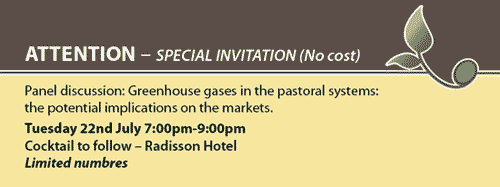Sponsored by the Embassy of New Zealand
ATTENDEES DATA BASE
Introduction
Agriculture greenhouse gas emissions – a global context
The agriculture sector produces between 12 and 14 percent of global greenhouse gas emissions. Greenhouse gas emissions arising from the agriculture sector are from the following sources: methane from enteric fermentation, waste, biomass burning, rice production, and nitrous oxide from soils, biomass burning, and manure. Enteric methane and soil nitrous oxide constitutes the major share, producing 70 percent of all agricultural emissions.
Globally, greenhouse gas emissions from the agriculture sector have grown by nearly 17 percent from 1990 to 2005. During that period, developing regions showed a 32 percent increase, and were, by 2005, responsible for about three quarters of total agricultural emissions.
Globally, within the agriculture sector, livestock production and in particular, grazing livestock systems occupy between 26 and 40 percent of the total land area of the world. The livestock sector emits 37 percent of anthropogenic methane (mostly from enteric fermentation from ruminants) and 65 percent of anthropogenic nitrous oxide. The vast majority of this is from grazing systems in Latin America and Asia.
Workshop focus
This workshop is intended to bring together policy, science and industry with a collective interest in grazing livestock systems and will focus on the measurement, verification and reporting of greenhouse gas emissions in this sector. Specific topics to be covered include: characterising livestock populations that vary over time and space, moving from IPCC defaults to country specific values, modelling greenhouse gas emissions at various scales, capturing activity data,
Mitigation is a major challenge in this sector. Globally, we need to devise mitigation strategies that are cost-effective and fit within different farming systems. Food demand is growing as population and income increases, and rising food costs around the world are increasing food security concerns. We need to find mitigation solutions that do not have a detrimental effect on productivity. With this is mind, a core part of the workshop is to discuss alternative methods of mitigation and methods for the incorporation of these mitigation strategies into national greenhouse gas inventories in order for any greenhouse gas reduction to be realised.
Outcomes sought:
- MoU on CDM methodology development
- Four way calibration of methane estimation
LEARN
Livestock Emissions & Abatement Research Network
The aim of LEARN is to facilitate collaborative research between international researchers to enable us to better understand greenhouse gas emissions from livestock and develop cost-effective and practical means to reduce these emissions.
LEARN will focus on sharing information, facilitating discussion and promoting face to face contact between researchers around the world.
New Zealand hosted the first meeting of the LEARN network in December 2007. Over 50 delegates from 25 countries in Australasia, Asia, Africa, South, Central and North America, and Europe met to discuss and agree on the objectives, focus areas, administration and governance of LEARN.
The meeting agreed the following objectives and focus areas:
Network Objectives
- To improve understanding, measurement and monitoring of non-CO2 greenhouse gas emissions from animal agriculture at all scales; and
- To facilitate the development of cost effective and practical greenhouse gas mitigation solutions.
Initial Focus Areas
Methane emissions from ruminant livestock;
Nitrous oxide emissions from ruminant livestock;
Integrated assessment of whole farming system impacts at all scales (including region and watershed);
National agriculture inventory development.
Future Focus Area
- Broaden network activities to other livestock and farm systems.
Governance and Administration
New Zealand chairs the LEARN Advisory Group, and acts as administrator of LEARN.
New Zealand has committed funding to support the ongoing activities of LEARN including website, conference sponsorship, workshops, secondments and exchanges and is looking for other interested countries to contribute funding to support its activities.
The website address for information
or to become a LEARN member is: www.livestockemissions.net/
